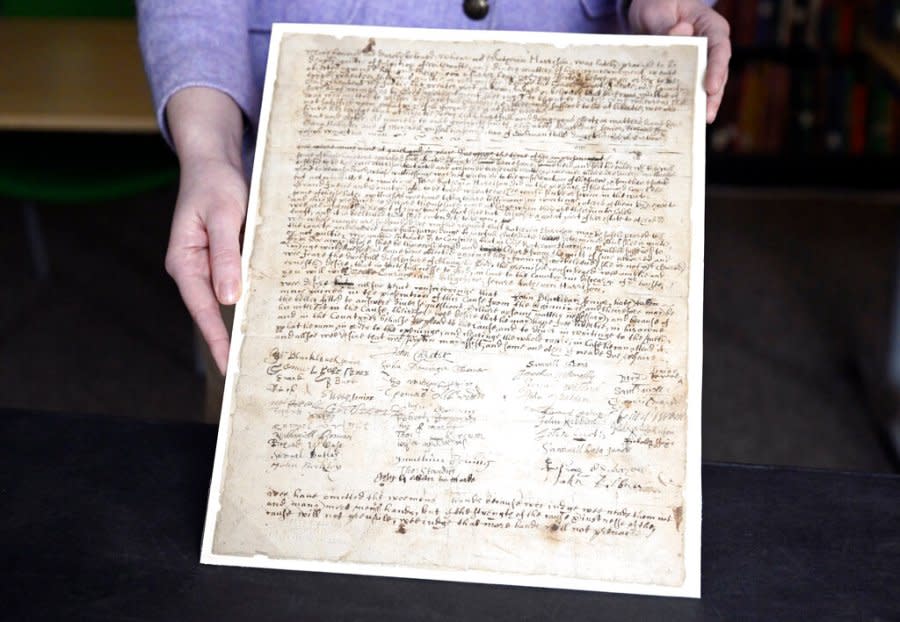Connecticut group urges state to exonerate witch trial victims over 300 years later
- Oops!Something went wrong.Please try again later.
(WTNH) — It’s been over 300 years since 34 men and women were accused of witchcraft in Connecticut. Now, they may have the chance to be exonerated.
While the history of witchcraft in Connecticut was difficult to track due to lack of documentation, the accusations led to the first large-scale witch trials in the American colonies, predating the infamous Salem Witch Trials by nearly 30 years.
During a resolution hearing on Wednesday, members of the Connecticut Witch Trial Exoneration Project (CWTEP) shared stories of the innocent witch-trial victims of the 17th-century Connecticut Colony.
The members urged the state of Connecticut to acknowledge the victims’ innocence.
CWTEP said legal procedures were “radically different” in the 17th century, and many court practices would no longer meet modern standards of proof today, according to court documents. Additionally, misogyny played a significant role in the trials and denied defendants their rights and dignity, CWTEP noted, which, combined with panic and superstition, led to the suffering of those accused.
Penguin to publish ‘classic’ Roald Dahl editions after ‘censorship’ controversy
The group asked the state to proclaim the innocence of those sentenced to death.
The following 11 Connecticut residents were executed for witchcraft between the 1640s and 1660s:
Alice Young (1647)
Mary Johnson (1648)
Joan Carrington (1651)
John Carrington (1651)
Goodwife Bassett (1651)
Goodwife Knapp (1653)
Lydia Gilbert (1654)
Mary Sanford (1662)
Nathaniel Greensmith (1663)
Rebecca Greensmith (1663)
Mary Barnes (1663)
In addition, CWTEP urged legislators to exonerate anyone who was indicted, forced to flee the state, banished — or even acquitted, but had their lives and reputations destroyed.
While not convicted, the following residents were said to have suffered after the year of their indictments (indicated in parentheses):
Goodwife Bailey (1655)
Nicholas Bailey (1655)
Elizabeth Godman (1655)
Elizabeth Garlick (1658)
Unknown person in Saybrook (1659)
Margaret Jennings (1661)
Nicholas Jennings (1661)
Judith Varlet (1662)
Andrew Sanford (1662)
William Ayers (1662)
Judith Ayers (1662)
James Wakely (1662)
Katherine Harrison (1668, 1669)
William Graves (1667)
Elizabeth Clawson (1692)
Hugh Crosia (1692)
Mercy Disborough (1692)
Mary Harvey (1692)
Hannah Harvey (1692)
Mary Staples (1692)
Winifred Benham (1697)
Winifred Benham Jr. (1697)
Elizabeth Seager (convicted and reprieved in 1665)
Although only 34 people were convicted of witchcraft, the trauma likely endured, with families forced to live in shame for generations. Because of this, CWTEP would like the state of Connecticut to formally apologize to the descendants of those indicted, convicted, and executed for witchcraft.

Chief Attorney Sandra Norman-Eady and Librarian Jennifer Bernier of the Connecticut General Assembly said that while historians cannot say with absolute certainty what gave rise to the witch trials in Connecticut, many believe the primary cause was simply fear. Colonists needed something — or someone — to explain hardships like floods and epidemical sickness, and Satan was a prime suspect.
Witchcraft, defined as a crime of “conjuration” and “dealing with evil and wicked spirits,” has transformed in modern society. The Wicca modern pagan syncretic religion, which grew in the ’50s, delves into self-help, healing and divination.
For the latest news, weather, sports, and streaming video, head to The Hill.

